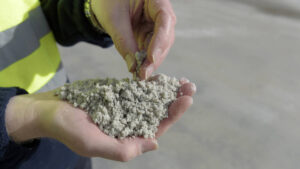Pan Asia Metals bumps up anomalous zone 2.8x at Thai lithium project

The company is planning further sampling at the project. Pic: Getty Images.
- Fieldwork extends anomalous zone at RK lithium project by 2.8x
- Pegmatites suggest KT East prospect likely amenable to open pit mining
- KT East has a larger footprint than the RK and BT Lithium Prospects combined
Special Report: Battery and critical metals explorer and developer, Pan Asia Metals says field work at the KT East lithium prospect – part of the broader RK project in Thailand – has increased the anomalous zone by 2.8x to 2.1km long and 1km wide.
This comes after the company reported last month that rock chip sampling had defined the prospective zone over a strike length of ~2.4km and a width of at least 2.4km.
The results of soil sampling combined with the previous rock chip sampling program indicates the pegmatite field occurs over a strike length of approximately 2.1km and a width of approximately 1km, increasing the zone by 2.8x on that previously reported.
The large coherent Main Zone is approximately 2.0km long and up to 500m wide and contains numerous zones of lepidolite pegmatites.
The pegmatite dyke swarm remains open in several areas where additional sampling is planned, with many individual dykes 7-10m wide and up to 20m wide.
Notably, the pegmatites are stacked and dip moderately, suggesting KT East is likely amenable to open pit mining with potentially low strip ratios, the company says.
KT East a promising prospect
So far, the KT East prospect has a larger footprint than the RK and BT Lithium Prospects combined, with the north-western prospect area associated with extensive historic tin mining.
“These results cement previous reports that the KT Lithium Prospect is extensive, and confirm that the pegmatite field is approximately 2.1km in length and 1.0km wide, 2.8x that previously reported with most of this captured in the ‘Main Zone’,” Pan Asia Metals (ASX:PAM) managing director Paul Lock said.
“PAM’s field team will continue with the grid-based soil and rock-chip sampling and geological mapping program, chasing down several areas which remain open to the northwest of the Main Zone and where there is a considerable area of historical tin mine workings.
“There are several walk-up drill targets and the team will continue to investigate other drill sites, with drilling expected to start later this year.
“KT East is proving to be a substantial addition to the RK Lithium Project, with the KT East Prospect larger than the RK and BT Prospects combined.
“KT East has the potential to add substantial LCE tonnes to the RK lithium project.”
A competitive lithium project
“Although the underlying lithium price is off, we are looking at the bigger picture as battery demand continues on its growth path and PAM is in a low-cost environment,” Lock said.
“Therefore, we expect that the RK Lithium Project, like its Chinese lepidolite counterparts, will out-compete many of the hard rock lithium projects on the basis of the cost environment, which applies to both capital and operating costs, and proximity to markets for both inputs and end products.
“Limestone is one such product, with Australian lithium processors importing their limestone requirements from Thailand.
“The field results being reported herein will continue to feed into discussions with potential strategic partners.”
 KT East lithium prospect, RK and BT lithium prospect comparison. Pic: PAM.
KT East lithium prospect, RK and BT lithium prospect comparison. Pic: PAM.
Next steps
Combined with rock-chip sampling, PAM is conducting soil sampling in areas where soil anomalism remains open around the Main Zone.
The company is also considering a trenching program which may also act as site access preparation for drilling planned for later this year.
Additional reconnaissance sampling is also planned within the license area especially at KT East NW where large scale historic surface mining for tin has been undertaken and where anomalous rubidium and lithium have been located in rock-chip and tailings samples.
This article was developed in collaboration with Pan Asia Metals, a Stockhead advertiser at the time of publishing.
This article does not constitute financial product advice. You should consider obtaining independent advice before making any financial decisions.
Related Topics

UNLOCK INSIGHTS
Discover the untold stories of emerging ASX stocks.
Daily news and expert analysis, it's free to subscribe.
By proceeding, you confirm you understand that we handle personal information in accordance with our Privacy Policy.








